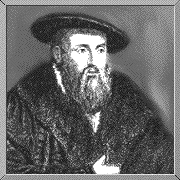 Johannes
Kepler was born on December 27, 1571. Kepler attended
school in Adelberg, Tubingen, and Maulbronn, Germany. Upon completion
of his formal education, he accepted a position as chair in
mathematics and astronomy at Graz, Germany. His first writing
(Cosmographic Mystery written in 1596) supported the work of
Copernicus. This work supported the idea that the sun, not the earth,
was the center of the solar system.
Johannes
Kepler was born on December 27, 1571. Kepler attended
school in Adelberg, Tubingen, and Maulbronn, Germany. Upon completion
of his formal education, he accepted a position as chair in
mathematics and astronomy at Graz, Germany. His first writing
(Cosmographic Mystery written in 1596) supported the work of
Copernicus. This work supported the idea that the sun, not the earth,
was the center of the solar system.
Early in his career he studied the planet Mars. Kepler proved that the orbit of Mars is an ellipse with the Sun occupying one of its foci. This observation was the basis of his first law of planetary motion, the one that states that planets travel in elliptical orbits. His second law of planetary motion, published in 1609, describes the concept of planetary velocity. His third law, published in 1619, describes the relationship between the orbital periods of the planets and their distances from the Sun. His work was the foundation for Newton's theory of gravitation.
In other writings, Kepler dealt with optics (1604), telescope lenses (1611), the appearance of a nova (1604), and Galileo's astronomical observations (1910). Kepler's last work, known as the Rudolphine Tables, was a widely used compilation of tables of planetary motion. Kepler died on November 15, 1630.
References
Asimov, I. (1964). Asimov's Biographical Encyclopedia of Science and Technology: The Living Stores of More than 1000 Great Scientists from the Age of Greece to the Space Age Chronologically Arranged. Garden City, NJ: Doubleday.
Daintith, J. Mitchell, S., Tootill, E. (1981). A Biographical Encyclopedia of Scientists. New York: Facts on File.
Debus, A.G. (1968). World Who's Who in Science: A Biographical Dictionary of Notable Scientists from Antiquity to the Present. Chicago: Marquis.
Howard, A.V. (1951). Chamber's Dictionary of Scientists. London: Chambers.
McGraw-Hill (1966). McGraw-Hill Modern Men of Science. New York: McGraw Hill.
Taton, R. (Ed.) (1963). History of Science: Ancient and Medieval Science from the Beginnings to 1450. New York: Basic Books.